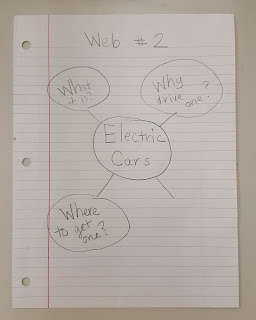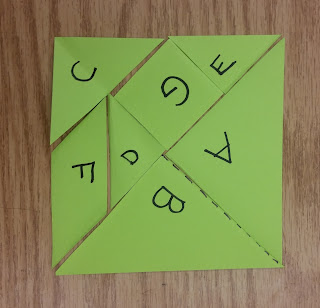WRITING
This week in writing we switched writing modes. To help them transition from our narrative writing practice to informational writing, we took another look at author's purpose.
Early in the year we discussed why writer's write as we looked at the various texts and the purpose the writer has for creating them. The concept of author's purpose crosses over from reading to writing. To better solidify this knowledge, we took another look at the acronym P.I.E. which stands for Persuade, Inform, and Entertain. These are the main reasons writer's write.
After revisiting this information, I explained to the students that our purpose for writing was changing from "entertaining" to "informing" as we moved into our informational writing mode.
We took some time to examine the characteristics of informational writing--examples of texts, organization of text, and features of text.
Students learned that their first informational article will be about a topic they already know a lot about, whereas their second informational article will be about a topic they can research and learn about.
Students were then asked to think about the "expert topics" they could potentially write about, as they filled out the organizer below.
Our next step was to choose 3 topics from our list and begin planning the main ideas we want to teach about each topic. We again used a web as a helpful graphic for showing our topic and main ideas.
I modeled the examples below.
It is crucial that the students have clear main ideas relating to their topics. The organization of their writing piece will revolve entirely around them. They will be encouraged to choose 2-4 to focus on. Please ask your child to discuss their topic, and the main ideas they could teach about that topic. The better they are at talking about it, the better they'll be at writing about it.
On Wednesday, we spent our entire writing session taking turns sharing our favorite web - communicating our topic and main ideas to the class.
This was good practice, and drew special attention to the difference between a topic and main idea.
Along the way, we were able to recognize if someone mistakenly inserted a detail into their web, rather than a main idea (we were not to that point yet).
We had several meaningful discussions about the difference between a main idea and a detail, and how knowing the difference between the two concepts is super important during the planning stage of the writing process.
Each main idea will become a well-developed paragraph, with many supporting details. If we try to write a well-developed paragraph starting from a single detail, we will struggle. This understanding is crucial to success in informational writing.
MATH
In math we began Unit 3 of our math curriculum focusing on Geometry.
I started out by asking students to share what they already knew about Geometry. Students worked in pairs to discuss and record what they know, before sharing out to the class.
Next, I gave each pair of students a shape, and asked them to write down as much as they could about that shape.
Then students had a chance to share their shape and descriptions with the rest of the class.
I learned that the students have a pretty good understanding of various shapes and the mathematical vocabulary used to describe shapes.
Next, students engaged in a shape classification activity. They worked in small groups to sort and classify a bag of shapes.
They were asked to sort the shapes anyway they wanted, using any characteristics.
The students then rotated around the room to examine the sorts, trying to guess how the shapes were separated. The labels were placed face down, so groups had a chance to guess before looking at the answer.
The next two days of math revolved around the following goal.
We started out with a 6 x 6 inch square.
Then, with good listening skills and dexterity, the students followed along as I gave directions on how to fold and cut the shapes.
The result was a step-by-step opportunity to examine the relationship between various shapes. As we went along, we stopped and recorded some the vocabulary that was naturally being demonstrated.
This activity was a classic example of the constructivist methodology of teaching, which is very characteristic of our Bridges Mathematics Curriculum. Instead of teaching rote memorization of concepts, students engage in an activity that makes meaning for them, before it gives the concept a label. This makes the learning concrete and tangible, instead of abstract, like so many math concepts.
The activity resulted in a set of tangrams.
The following day, the students used these tangrams to complete an activity that challenged them to build various shapes out the tangram pieces.
This directly targeted their ability to visually recognize shapes within shapes. The greater challenge came from the progression from attempting to build a shape with exactly 2 pieces, then exactly 3 pieces, up through 4, 5, 6 and 7 pieces. If a designated shape could not be built using the pieces, they were asked to place an X through that box.
Next up, we dove into an intense vocabulary study as we took notes and drew diagrams in our math journals for future reference.
We began with defining and diagramming some basic terms to know when talking about shapes.
Part of this introduction involved describing basic types of lines.
Then we played a game called "dots and lines". Pairs of students competed in a game of making squares! Each student spins to decide whether they have to draw a line that is perpendicular or parallel to the given start line. The object of the game is to create squares with each line you make.
SCIENCE
In Science we have begun our second unit of study,
Changes: Experiments with Matter.
This is a basic chemistry unit where students explore the characteristics of solids, liquids, and gases, and conduct experiments that involve the observation and manipulation of changes in matter.
We began by working in partners to brainstorm examples of
solids, liquids, and gases.
The class came up with the examples below.
Next, we searched through magazines looking for images of solids, liquids, and gases, in order to demonstrate our understanding in a visual collage.
Then, we took an in depth look at what solids, liquids, and gases are and how they behave. We explored this information through drawings, discussions, and short videos, that all convey the clear differences between the three main states of matter.

The students have learned that “particles” make up all matter, and the particles of a solid, while they may look the same, behave differently than the particles of a liquid. This different behavior is what determines which state of matter exists.
In order to demonstrate a basic understanding of particles of matter each student created an illustration of a solid, liquid, or gas, showing the particles of matter and their placement.
In a solid, you can see the particles packed close together, in an orderly manner.
In the liquid the particles are more spread out and can slide past each other.

 While in a gas the particles are spread out even more, and can move freely.
While in a gas the particles are spread out even more, and can move freely.
This was a fun way for the students to show their abstract thinking about matter.
We even spent time simulating the states of matter using ourselves as the particles. Each group of students had to arrange themselves in the various positions that the particles would take in the various states. As I called out the various states of matter, they had to rearrange themselves (as particles) accordingly. They had fun and showed an understanding of the particles of matter.
This week during our two short days together, we will spend some time recording what we've been learning in our "Changes" Science Journal, before we begin our actual experiments.
ART
On Friday, our art session consisted of a variety of creative activities that required each student to focus on whatever they needed to complete.
Some students finished up their watercolor painting of their summer moment.




Some students finished up their solid, liquid, and gas collages, or their particle illustrations.
Finally, those who were finished practiced their symmetry drawing skills as they chose an insect to draw and color.
IMPORTANT DATES
November 23-25 NO SCHOOl- Thanksgiving Break
































































































